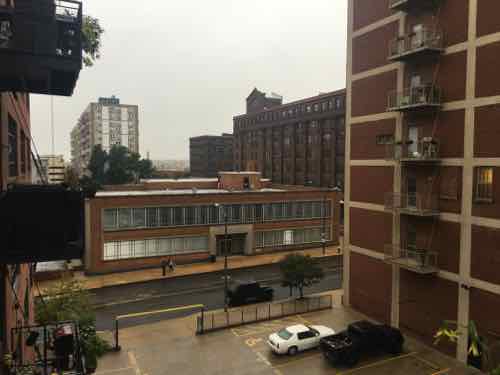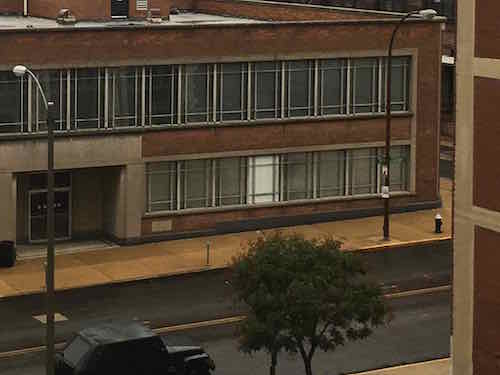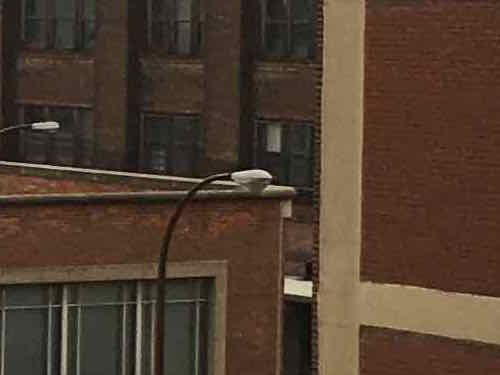Cobra Heads Shine Light Up Into Our 4th Floor Windows
Street lights are important for safety, so motorists and pedestrians can see better at night. Good lighting can help reduce crime. Sadly, most cities, including St. Louis, have bad lighting. Instead of lighting the road and sidewalks we also light up the night sky.
The International Dark-Sky Association estimates that 1/3 of all lighting is wasted at an annual cost of $2.2 BILLION dollars. The light projected directly upwards from a cobra-head streetlight is about 30% of the total light it emits! (James Mason University/John C. Wells Planetarium: Light Pollution: The Overuse & Misuse of Artificial Light at Night)
Our loft is on the 4th floor of our building, our windows don’t directly face Locust St. Still, a cobra head light across the street blasts our uncovered windows with light every night.



The solution is to replace the old cobra head lights with more efficient LED lights, right?
The new plan for security was put in place before the recent robberies. It calls for four more surveillance cameras, license plate recognition cameras, and brighter street lights.
“What we want now are the surveillance cameras that have red and blue flashing lights on them so that people realize they are on camera and that is a really critical next step to make people realize this is a watched area,” said Missy Kelley with Downtown St. Louis, Inc.
The plan calls for all 3,000 downtown street lights to be replaced with LED lights that are brighter.
“Change out all of the cobra head lights downtown to LED lights which are brighter and whiter and will splash back onto the sidewalk. They will light the streets but also light the sidewalks,” Kelley said.
Areas around the Busch Stadium, the Peabody Opera House and Scottrade Center will see the new lighting first. (More security measures coming to downtown St. Louis)
The word “brighter” was used three times in the above quote. But, again, LEDs are the solution, right?
Not necessarily says the International Dark-Sky Association — they detail five myths about LED streetlights:
- Myth #1: The use of LEDs reduces light pollution and is “good for dark skies” because they’re highly energy efficient.
- Myth #2: The use of LEDs reduces light pollution and is “good for dark skies” because they make it easier to control where the light lands on the ground.
- Myth #3: LED lighting increases traffic safety
- Myth #4: LED lighting improves security by discouraging crime.
- Myth #5: Energy savings from LEDs automatically means a lower carbon footprint, which is better for the environment.
Just like most regions, we’re replacing bright cobra heads that scattered light in all directions with brighter LEDs that scatter more light in slightly less directions. Brighter isn’t necessarily better or even safer.
— Steve Patterson
One redeeming factor associated with having a job that puts me in several pre-construction meetings a week, with owners, architects and engineers of every type imaginable, is that I’m witness to building issues and potential problems that have to be addressed during the design phase. It’s like watching segments of This Old House and getting paid for it!
Often the issue of “light pollution” raises its ugly head, giving an opportunity for the snarky little “lighting consultant/engineer” sitting at the table to pontificate and justify his travel expenses by offering recommendations to address this problem. Always, and without fail, the lighting consultant will clear his throat, then vow to go back to his office, research the issue, and then recommend to the architect one of several “light shields” that are available to “mitigate” “light drift”. Then everyone smiles, and then the next issue is addressed. And life goes on. ***You may want to contact the STL Lighting Division for their help.
One, I agree with your analysis. Two, in general, St. Louis has far too many streetlights – taking out every other one would be a huge step in the right direction, with no impact on “safety”. But, three, the streetlight was there before you guys, so it was a known entity (or should have been), so griping about it, after the fact, is no different than a suburbanite who moves in next to a pig farm and complains about the smell!
……I long for the day when I can wake up in the morning and smell the pigs and the goats……It’s usually not the smell of the actual pig or goat that suburbanites complain about. It’s what they leave behind that they object to, especially in July and August and after a rainfall. When God created the pig and the goat, one of his 12 disciples sitting next to Him at the table should have addressed this wretched byproduct, long before the first prototype of each species was released for fabrication.
We’re thinking of going the condo route, so we were wondering a few things…
Do you guys rent or own? If you own, what’s the monthly association fee and what does it cover? Is parking included?
Overall, what’s the upside of living in a downtown loft and what’s the downside, if any?
Off topic, but I’ll indulge. We own, I bought almost 9 years ago. Monthly condo fees vary widely from development to development, but they generally over everything outside of the interior of your unit. Ours happens to include Internet.
Parking depends on the project, ours has a space with each unit. Our space is a single, some are tall and the owner has a lift. Some are wide and they can squeeze two cars in side by side. A few are tandem spaces.
The upside of condo life is you don’t have to spend the weekends mowing grass, painting, cleaning gutters, etc. The downside is the owners must agree on budgets and maintenance. I served a 3-year term on our board — not an easy job.
Before buying I’d suggest renting downtown for a year to make sure it’s right for you.
…my two cents worth…
Steve’s right. Don’t buy until you’ve rented at least a year. And remember that all condos are NOT created equal. Some were actually designed with the comfort of future residents in mind, while others were NOT! Some were responsibly and thoroughly renovated; others were not! Stay away from those that were not. When you own a condo unit in a building along with 49 other condo units, you don’t own just your own condo unit, but you also own 1/50th of the entire building. There is no “they” in the condo world as it relates to responsibility for common area maintenance. WE is the operative pronoun. So you’ve bought into a building whose roof, exterior masonry walls, hvac systems, plumbing, sewers, elevators, indoor parking decks, electrical distribution system, fire sprinkler system–etc, etc, etc ….you will own 1/50th of! This can be a good thing or a bad thing. It’s good if the building was renovated properly and if the building is in good shape. If your building’s developer was less than reputable, then you’ll own 1/50th of a money pit. My suggestion: after your 1 year trial period, BEFORE you purchase anything, hire a qualified building inspector to inspect the condo unit you are interested in AND ESPECIALLY to inspect the entire condo building: condition of exterior masonry, roof, hvac, glass systems, plumbing, interior parking decks, etc etc etc. Then if all seems perfect, then talk with the condo board and inspect the “books” to verify if the condo association appears to have set aside adequate cash reserves to avoid the need for special assessments. EYES WIDE OPEN!!!
“Good lighting can help reduce crime.”
While not false, I think this is an oversimplification. Or at least, it’s interpreted that “good”=”more”. More light is actually harmful, because bright light means “darker” shadows by way of contrast. As you are obviously aware from the spillage from these street lights, the perceived light is a function of the physical lighting plus the reaction from your own eyes based on nearby light sources.
In a perfect world, there would be very low levels of uniform illumination, say a low-wattage, warmly colored light every few dozen feet. In reality, we get cold, harsh blue LED fixtures and over-lighting, leading to reduced safety.